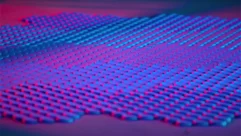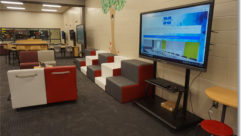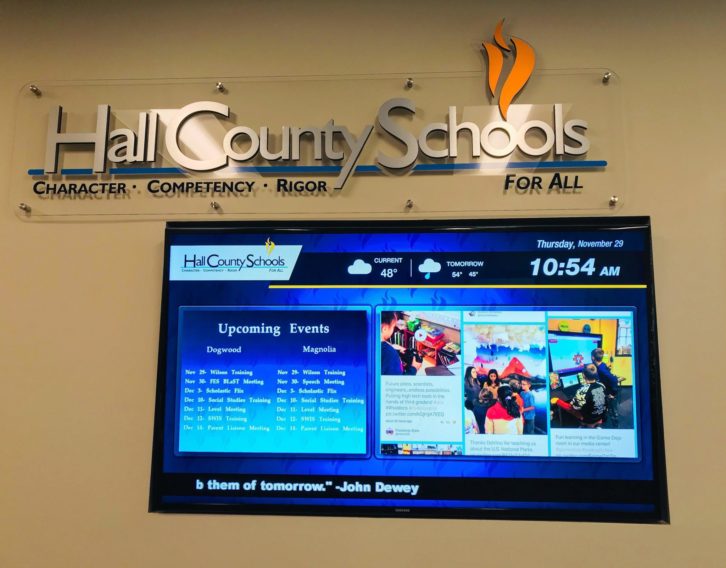 Hall County Schools take the technology lead with Solstice wireless collaboration systems, Epson projectors and Clear Touch interactive panels.
Hall County Schools take the technology lead with Solstice wireless collaboration systems, Epson projectors and Clear Touch interactive panels.
On this edition of the SVC Podcast, Contributing Editor Bennett Liles continues his conversation with Adam Yates of the Nisewonger Audio Visual Center in Lawrenceville, Georgia about their installation of an all new Visix digital signage and AV collaboration system for the Hall County School District. Adam provides details on the new collaboration technology that is currently being installed in Hall County Schools.
FOR MORE: GO TO PART 1
Links:
- Solstice wireless collaboration platform
- Cloud Electronics Presentation Systems with zoned audio control
- Clear Touch interactive panels
- Epson interactive projectors
TRANSCRIPT:
The Hall County schools needed a unified system for digital signage and they wanted to add wireless collaboration tools. Nisewonger Audio Visual Center in nearby Lawrenceville, Georgia answered the call with Visix digital signage, Solstice collaboration and Cloud Electronics. Project Sales Engineer Adam Yates is back to finish his story on how it’s all getting done.
Adam, good to have you back with us on the SVC Podcast from Nisewonger Audio Visual Center in Lawrenceville, Georgia.
Yes, sir. Thank you. Thanks for having me.
We got into a big-scale, ongoing project that you have for the Hall County School System involving Visix digital signage across the whole school district where they were using various different systems before. Part of this was collaboration technology so what sort of collaboration solution were the Hall County schools looking for with this?
Really it started out as collaboration for typically a learning commons or media center space. That’s kind of how it started. Not necessarily in the classroom but in those commons areas of the school system. They wanted a system that was easy to use that could work across all platforms. I mean there’s so many devices on the market they wanted something agnostic that could handle those different types of devices. And really the key was multiple students sharing information at the same time on the same display. And so this was kind of geared toward, again, that learning commons space where you had small groups of individuals coming together working on a project or working on a specific assignment together. [Timestamp: 1:42]
And you’re certainly no newcomers to this. You’ve been doing this for a long time so why did you decide to use the Solstice wireless collaboration system from Mersive?
Yes. So Solstice was the one that we had created a relationship with these guys many years ago. They were – I don’t want to say they were the first to market, but they were in pretty quickly, in pretty early on in this idea of collaboration huddle spaces, things like that. And we really took our time with this. We kind of scoured the marketplace for the best solution that really offered the most user-friendly interface and the network connectivity. So we were careful not to jump in on the cheapest solution just because it’s K-12. We were careful not to jump in there. We took our time and we just wanted to make sure that we had a great solution that would work in many different environments with many different devices and the Solstice achieves that. [Timestamp: 2.34]
And of course you’ve got to have scalability because the student body in these schools are not getting smaller, they’re getting bigger so you’ve got to look at expansion some time or other.
Yeah, absolutely. The great thing about these wireless vibration devices, I mean they sit on the network and they allow multiple students to connect with multiple devices at the same time and they allow students to jump in and out of those connections. As the class size increases or changes they can be very flexible to that.
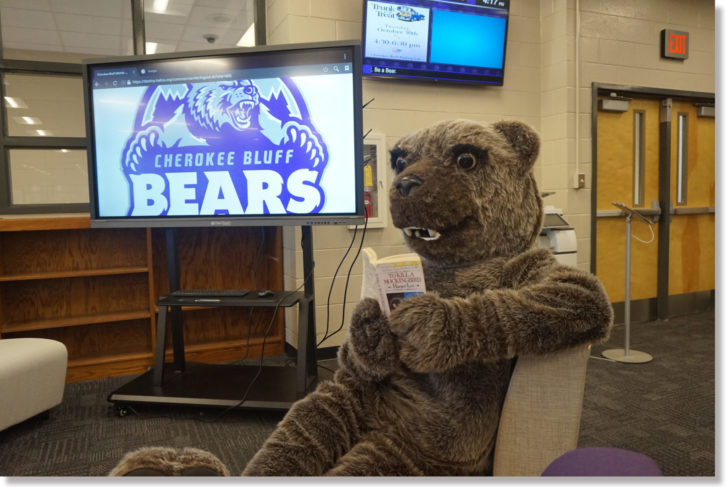
And putting in these collaboration systems probably gets the students engaged and motivated more than anything else when they’re able to jump right in and compare notes with each other.
Yeah, absolutely. And that was really the requirement. We started seeing the need and the desire for more small group work, more group work working together. It was kind of like we have all these devices, we have all this information, and using a wireless solution like this, and something that goes beyond just the one-to-one type connection were you can have multiple devices on the screen at the same time – you can resize windows and you can zoom into a specific area and things like that – really made a lot of sense for that type of work. [Timestamp: 3:41]
You also installed Cloud Electronics presentation systems so how do those work?
Yeah. So Cloud Electronics, they are a European-based manufacturer of audio solutions equipment. So we utilize their equipment in our AV designs most specifically when we get into the idea of room audio zoning. So what that means is if you’re looking at a learning commons, a media center space, we may have the need for a two to three zone audio system where we have a classroom area that needs a specific zone zoned out for audio where the instructor may need to play audio from a laptop or may need to use a microphone in that area while another zone or another area of the media center, say kind of a hangout area or something like that, may just need some background music. And then you have another area that may be a small group space where a student needs to connect their device and play a video presentation or something like that. So those products allow us to be able to zone out that audio and create different zones within one single space. [Timestamp: 4:48]
And how is that controlled?
So that’s typically controlled from an audio control played on the wall. So each zone may have a little button controller that you select the source and you can adjust the volume for that particular source in that particular zone. So it’s very simple. It’s very easy to use. You walk up to that zone, you select your source, whether it be blue-tooth audio or whether it be from your laptop or whatever, and then you can adjust the volume of that particular zone. [Timestamp: 5:14]
OK so you’ve got to have a system that’s easy to operate and I would think that you provided some instruction on all these things to the faculty and media specialists.
Yeah, absolutely. And that’s part of really what we do and who we are. We have a dedicated person that takes care of any kind of technical problem issue that arises. He takes care of our training and our programming and some of those things. When we put in these systems, when we initiate them, we set up a training session for the main users or we do a train-the-trainer type session and go over exactly how to operate that system. And even in some cases give them some kind of basic operating guidelines for the system. [Timestamp: 5:55]
There was projector installation also involved in this since they’re still the low-cost solution to very large displays. Those were Epson projectors?
Correct. Yeah, correct. So Hall County kind of specified Epson as their projector of choice, and so typically we were installing those in these leaning commons spaces. And also with that where we really got started in the media center/learning commons spaces, we actually go a lot further with that. So we’re not only designing and implementing the AV system, but we’re designing the furniture interior design layout of these spaces. So we’re actually able to come in – we’ve done this for now six different learning commons spaces in Hall County – so where we actually come in and we design the space. We take the space and we design the furniture layout. Get with the administrators, get with the district office and kind of get their vision for the space and how they see it being utilized, and then we come in and kind of transform that with all the furniture and then integrate the technology into that furniture. This is where we have collaboration zones. And then we can kind of design our AV system around that because now we know within this space this is a teaching area, this is a reading area, this is a small group area. And so we can design the whole system around that. [Timestamp: 7:14]
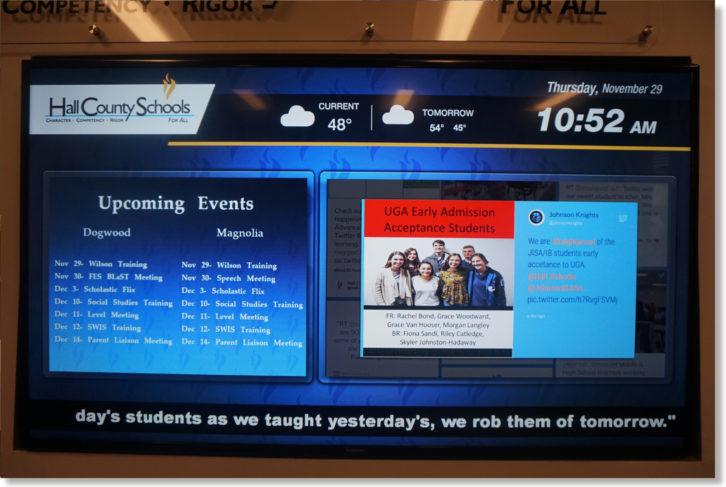
And there are a lot of great examples of that on your web site showing the classroom furniture in media and library areas. Some really imaginative designs I must say.
Yeah. Thank you.
What are the features on the Clear Touch interactive panels? How are they used? I believe those are the 6000U Series.
Yes. Right now Hall County, they have roughly I’d say 20-25 of these interactive panels throughout the district. And typically we were putting them in these learning commons spaces/media centers, as we’re renovating those. And typically most of the time they’re going on mobile carts and so what that allows them to do is the students, faculty, the media center specialists, they can move that interactive panel over to create any kind of small group environment and have an interactive panel to be able to utilize during that session. So these interactive panels, they come built in with an Android OS and then an option to add a PC module in. And most of Hall County have the built-in PC module that has an i5 processor. It comes with a full software suite that includes some educational software as well as some white-boarding tools and things like that. And so that’s where in the learning commons spaces and then kind of in those nontraditional classroom spaces, athletics, that’s where we’re putting these Clear Touch displays in. [Timestamp: 8:32]
Were there any specific things you had to do to futureproof all of this stuff as much as possible?
We try to think about that. As we do any kind of design work, as we’re implementing different technology, we’ve always tried to stay kind of on that cutting edge of technology in the education space and try to think ahead. I remember four or five years back I think we were one of the only integrators out there with an interactive panel at that time. Clear Touch didn’t exist and some of the other ones did not exist yet. It was kind of new in education and everybody looked at it and said, “I don’t know about that.” And now it’s becoming the most common piece of technology that’s going in the classroom today. So our job is to stay ahead of the curve on the technology that schools are using. So we were always thinking ahead. Another example of that is moving to an HDBaseT technology. Most of the café systems that we do – gymnasiums, auditoriums, those like that – we’re sending signal and in most cases via HDBaseT which carries power, video and control over one single cable. And what that allows us to do in a lot of instances is we can turn on and off projectors from a wall plate using one cable. It gives us the ability to hey, maybe they don’t need the full capability right now, but they might in a couple of years and the capability will already be there for them. So that’s how we’re kind of thinking through of how to future-proof these systems. [Timestamp: 9:59]
So what’s the learning curve been like on the systems you put in? Have they picked up on it pretty quickly?
Yeah, you know they really have. I mean with Visix it was pretty impressive. They were able to kind of pick up on the software side of it and learn pretty quickly. And we did some training with them with Visix and brought in the media specialist of each school because they’re really the ones kind of in charge of the digital signage platform and posting content and things like that. And the learning curve was pretty quick; I mean they were already used to another IPTV type solution already and so they had a little bit of knowledge in that to start with. They’re typically more tech-savvy and tech-experienced and so they were able to pick up on that pretty quickly. As far as the other systems that we implement we try to make it really as simple for the user as possible. And typically the more simple user interface requires more complexity on the back end. [Timestamp: 10:54]
And where are you in this Hall County project now? Are you still in the middle of it or where are you as far as completing the whole project?
From the digital signage point of view we just completed what I would consider Phase 2 of the rollout of Visix. So Phase 1 happened last – the end of spring/summer where we installed over 250 displays and we just installed and additional 70 players. And most of these were going on existing displays that were already in the schools and we were placing the existing technology with the newer Visix technology. [Timestamp: 11:26]
Well, as the other schools pick up on this I guess you’ve got plans for what you’re going to do after Hall County schools are taken care of.
Yes, absolutely. We’ve got some very exciting projects in the works. We just completed a 2×6 video wall for Fulton County schools, for their Emergency Operations Center where they check on things that are going on in the district. They keep up with weather and different security alerts and things like that. So we were able to put in Just Add Power AV over IP based switching system there where we’ve got over 20 sources and we displays with a vast array of switching capabilities. They have a very powerful system, incredibly powerful. And then we just designed and are getting ready to install a 3×3 video wall for a charter school system, their regional office. It’s Foothills Charter High School regional office in Athens. And that’s going to be an interesting project. That’s a 3×3 video wall that’s really going to operate like one large video screen and it’s going to be using LG displays, Just Add Power AV over IP based technology. It’s going to be awesome. It’s going to be awesome. [Timestamp: 12:35]
I know you’re looking forward to that. The Hall County School System has taken the technology lead now and giving the others some ideas. Good of you to take time to tell us about it. It’s Adam Yates, Project Sales Engineer for Nisewonger Audio Visual Center in Lawrenceville, Georgia. The North Atlanta area. You guys stay on top of it and good to have you with us.
Yes. Thank you, Bennett. I appreciate it.
Hall County Schools lead the pack now on unified digital signage with Visix, Solstice wireless collaboration and zoned audio control from Cloud Electronics. We’ve got more new AV installation case stories so next week get back with us for another one on the SVC Podcast.


